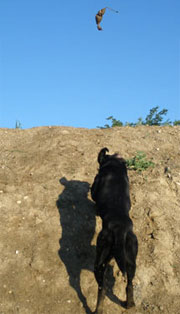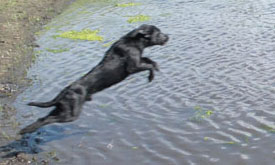| SportMutt - Premium TRAINING, PERFORMANCE and SPORTSMANSHIP for Dock Dogs, Dock Jumping Dogs, Big Air Dogs, and other Dog Performance Sports | ||||
|
|
|
Become a Conditioning Coach Contributed by Tom Dropik at SportMutt - December 2009 |
||
|
A record number of handlers, young, old, rookies, and veterans. A record number of dogs, Big Jumpers, Little Jumpers, and everything in between. 4 pools of non-stop 3 days of action packed jumping. 4 pools that supplied a platform for these wonderful teams to show of their wonderful athletic abilities. As my Young and Heart Tucker and I walked the grounds and my Non-Typical Rocky and I took to the docks for our 6th Nationals, I couldn’t help but notice how Well the Handlers did overall and on the dock. The obedience, the interaction, and techniques all were exceptional. This wonderful sport of ours had come a long way and the competitors have definitely benefited from the experiences of the sport. They’ve become better trainers and better role models. Then I got to thinking there is another area that has taken somewhat of a second seat to the techniques and is essential to performance and that is physical conditioning. Trainers must also make sure their dog is physically prepared, starting with a sound body, strengthened through exercise, proper nutrition and excellent health care. At SportMutt, we refer to this as the “Conditioning Coach.” As “Conditioning Coaches” we must understand that it is not enough to provide training without also providing the opportunity to become physically prepared. Physically fit dogs are better prepared for the demands of our sport such as the ability to get up to speed quicker and the ability to explode off the end of the dock. Also, a dog that remains physically active has less chance of becoming overweight which can lead to heart and lung problems as well as hip and joint problems. A physically fit dog leads a happier healthier life. When it comes to conditioning, we must understand that there are different ways that we can train to produce different Results. We must train to produce results that prepare us for our sport. After all, if a greyhound trained to build bulky, powerful strength, neglecting the build-up of strength endurance, then come race day, the dog would falter. Likewise, a dog that competes in sled-pulling and works on building up his aerobic strength and neglects power strength will be doomed at the starting line. Understanding the type of training necessary is key in dog performance. That way, we will never have to worry about bulky grey hounds and pencil-neck sled pullers. Make sense? A Dock Dog is similar to a fine tuned track athlete. After all, there’s the Long Jump (Big Air), the High Jump (Extreme Vertical), and Speed Retrieve (Tri Athlete). Three similar disciplines yet very different when it comes to Strength Training. In Big Air, Speed is primary and Lift is secondary. It is import to produce as much Speed as possible and produce as much Lift as we can with the amount of Speed obtained. In Extreme Vertical, Lift is primary and Speed is secondary. It is important to produce as much Lift as possible and just enough Speed to carry the dog to the object. In Speed Retrieve, Speed in primary on the dock and Strong swim finishes it off. That being said, it only makes sense that in the sport of Dock Jumping we need to focus on SPEED Strength. There are 2 types of Speed Strength: 1) Starting Strength The ability to turn on instantaneously as many muscle fibers as possible. The dog uses this for getting up to speed as quickly as possible on the dock. 2) Explosive Strength The ability to keep your muscle fibers turned on for an extended period of time against a resistance. The dog uses this to maintain the speed throughout the run as well as turning on more muscle to produce the Lift at take off. The idea is to build a program that is most beneficial to a dog, meets the expectations of a trainer’s goals, and utilizes both areas of Speed Strength training. This ideal Dock jumping Strength and Conditioning program combines Nutrition, Rest, and Variety. The Program should be in place year round with changes and variety in intensity. The intensity should be maxed prior to an event. We actually teach the muscles to peak, and we want to make sure they peak during an event. First and Foremost find a premium dog food that will meet the demands of this year round program and feed the proper proportions that meet the levels of the program through out the year. Dr. Brent Mayabb, DVM, Royal Canin USA, Inc. Technical Services Manager states “Energy comes from certain types of nutrients that are found in the dog’s diet. The specific nutrients that can be used to provide energy are protein, fat, and carbohydrate.”.
At SportMutt we make sure our dogs have what it takes to not only perform the exercise, but perform it to its full potential. Having the Energy not only accomplishes that which gives us maximum benefits, it also aids in the healing and rebuilding process. During a workout, muscles will break down and tissues with in the muscle will actually tear. It’s this healing process that actually rebuilds the tissue and makes its bigger and stronger. It’s the time during this healing process where the muscles require proteins and amino acids to not only speed the recovery process but provide the nutrients to become bigger and stronger. On what I call a typical working persons training day, because most of us have to work to make a living, the first thing we do in the morning is take the dogs to the field for a 10 – 15 minute run. This gets the blood circulating and the muscles warmed up. Then it’s a 10 minute drill, weather it’s a speed drill, strength drill, or speed swim drill. We’ll then immediately give them a 3/4 cup of dog food. The muscles are worked up at this point and starving for nutrition. We keep the portion small here because the dog is worked up. Too much and the dog will get rid of it, if you know what I mean. We’ll let the dogs rest for about 20 minutes then give them their remaining 1 ¼ cup of food for the morning.
Our afternoon starts with another 10-15 minute run in the field and another speed, strength, or speed drill. Then it’s a good 20 minute rest and we’ll feed them a full 2 cup portion. It’s very important to have variety in the program. Muscles can become conditioned to a routine and will become very difficult to rebuild if the routine is the same day in and day out. We need to refrain from routine so the muscle will condition itself to the change and learn to rebuild ever day. Not only that we like to keep it as fun and exciting as a work out can be. Always give a dog at least five days rest prior to an event. This will allow the muscle plenty of time for rebuilding and the dog will be more ready for the intensity of an event. Remember, dogs come in different sizes, shapes and age, and some have more ability than others. A training program should reflect these differences and be tailored to each dog. SportMutt recommends consulting a veterinarian prior to starting any strength program. |
||||
|
|
||||
|
|
||||


 Then
its rest time and off to work we go. This is a great time for the
muscles to heal, rebuild and utilize the nutrients of the morning feed.
Then
its rest time and off to work we go. This is a great time for the
muscles to heal, rebuild and utilize the nutrients of the morning feed.